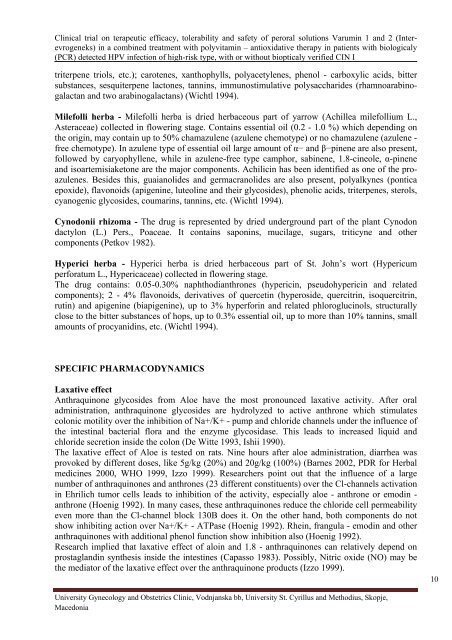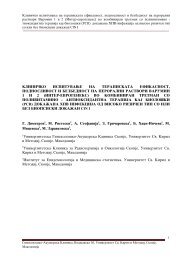klini^ko ispituvawe na terapiskata efikasnost, podnoslivost i
klini^ko ispituvawe na terapiskata efikasnost, podnoslivost i
klini^ko ispituvawe na terapiskata efikasnost, podnoslivost i
Create successful ePaper yourself
Turn your PDF publications into a flip-book with our unique Google optimized e-Paper software.
Clinical trial on terapeutic efficacy, tolerability and safety of peroral solutions Varumin 1 and 2 (Interevrogeneks)<br />
in a combined treatment with polyvitamin – antioxidative therapy in patients with biologicaly<br />
(PCR) detected HPV infection of high-risk type, with or without biopticaly verified CIN I<br />
triterpene triols, etc.); carotenes, xanthophylls, polyacetylenes, phenol - carboxylic acids, bitter<br />
substances, sesquiterpene lactones, tannins, immunostimulative polysaccharides (rhamnoarabinogalactan<br />
and two arabinogalactans) (Wichtl 1994).<br />
Milefolli herba - Milefolli herba is dried herbaceous part of yarrow (Achillea milefollium L.,<br />
Asteraceae) collected in flowering stage. Contains essential oil (0.2 - 1.0 %) which depending on<br />
the origin, may contain up to 50% chamazulene (azulene chemotype) or no chamazulene (azulene -<br />
free chemotype). In azulene type of essential oil large amount of α− and β−pinene are also present,<br />
followed by caryophyllene, while in azulene-free type camphor, sabinene, 1.8-cineole, α-pinene<br />
and isoartemisiaketone are the major components. Achilicin has been identified as one of the proazulenes.<br />
Besides this, guaianolides and germacranolides are also present, polyalkynes (pontica<br />
epoxide), flavonoids (apigenine, luteoline and their glycosides), phenolic acids, triterpenes, sterols,<br />
cyanogenic glycosides, coumarins, tannins, etc. (Wichtl 1994).<br />
Cynodonii rhizoma - The drug is represented by dried underground part of the plant Cynodon<br />
dactylon (L.) Pers., Poaceae. It contains saponins, mucilage, sugars, triticyne and other<br />
components (Petkov 1982).<br />
Hyperici herba - Hyperici herba is dried herbaceous part of St. John’s wort (Hypericum<br />
perforatum L., Hypericaceae) collected in flowering stage.<br />
The drug contains: 0.05-0.30% <strong>na</strong>phthodianthrones (hypericin, pseudohypericin and related<br />
components); 2 - 4% flavonoids, derivatives of quercetin (hyperoside, quercitrin, isoquercitrin,<br />
rutin) and apigenine (biapigenine), up to 3% hyperforin and related phloroglucinols, structurally<br />
close to the bitter substances of hops, up to 0.3% essential oil, up to more than 10% tannins, small<br />
amounts of procyanidins, etc. (Wichtl 1994).<br />
SPECIFIC PHARMACODYNAMICS<br />
Laxative effect<br />
Anthraquinone glycosides from Aloe have the most pronounced laxative activity. After oral<br />
administration, anthraquinone glycosides are hydrolyzed to active anthrone which stimulates<br />
colonic motility over the inhibition of Na+/K+ - pump and chloride channels under the influence of<br />
the intesti<strong>na</strong>l bacterial flora and the enzyme glycosidase. This leads to increased liquid and<br />
chloride secretion inside the colon (De Witte 1993, Ishii 1990).<br />
The laxative effect of Aloe is tested on rats. Nine hours after aloe administration, diarrhea was<br />
provoked by different doses, like 5g/kg (20%) and 20g/kg (100%) (Barnes 2002, PDR for Herbal<br />
medicines 2000, WHO 1999, Izzo 1999). Researchers point out that the influence of a large<br />
number of anthraquinones and anthrones (23 different constituents) over the Cl-channels activation<br />
in Ehrilich tumor cells leads to inhibition of the activity, especially aloe - anthrone or emodin -<br />
anthrone (Hoenig 1992). In many cases, these anthraquinones reduce the chloride cell permeability<br />
even more than the Cl-channel block 130B does it. On the other hand, both components do not<br />
show inhibiting action over Na+/K+ - ATPase (Hoenig 1992). Rhein, frangula - emodin and other<br />
anthraquinones with additio<strong>na</strong>l phenol function show inhibition also (Hoenig 1992).<br />
Research implied that laxative effect of aloin and 1.8 - anthraquinones can relatively depend on<br />
prostaglandin synthesis inside the intestines (Capasso 1983). Possibly, Nitric oxide (NO) may be<br />
the mediator of the laxative effect over the anthraquinone products (Izzo 1999).<br />
University Gynecology and Obstetrics Clinic, Vodnjanska bb, University St. Cyrillus and Methodius, Skopje,<br />
Macedonia<br />
10



